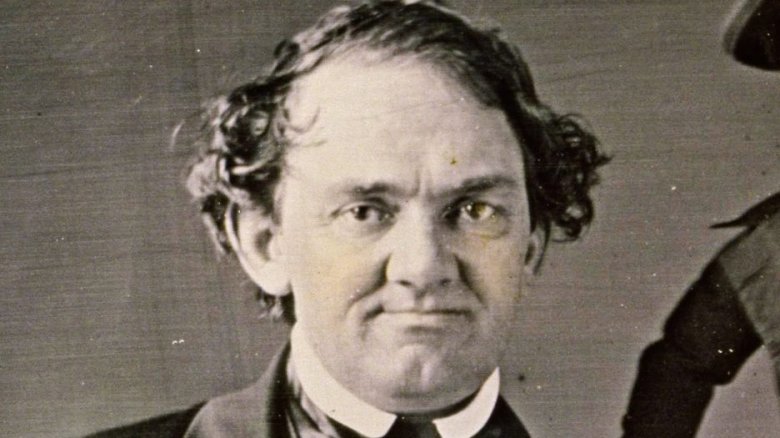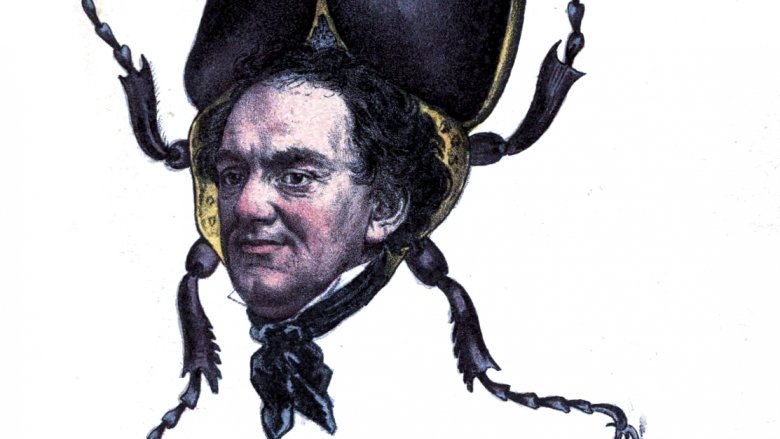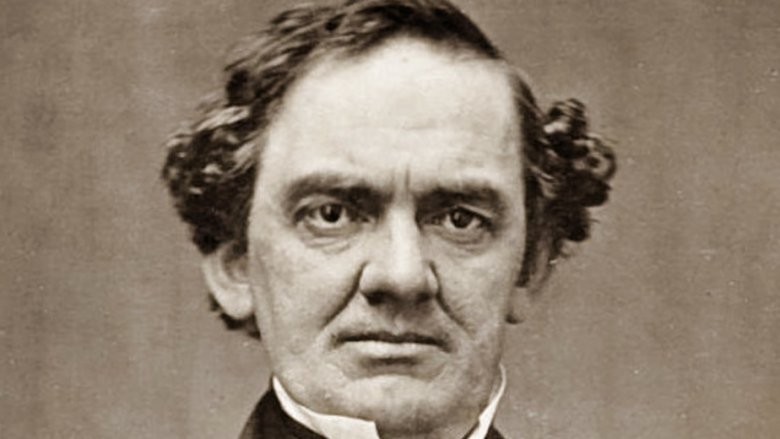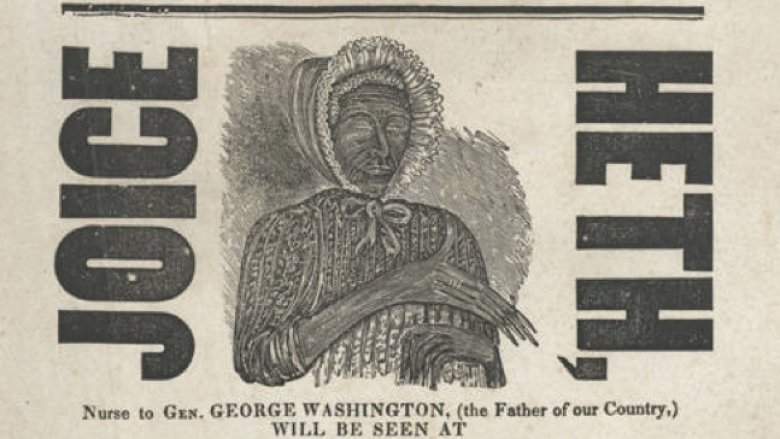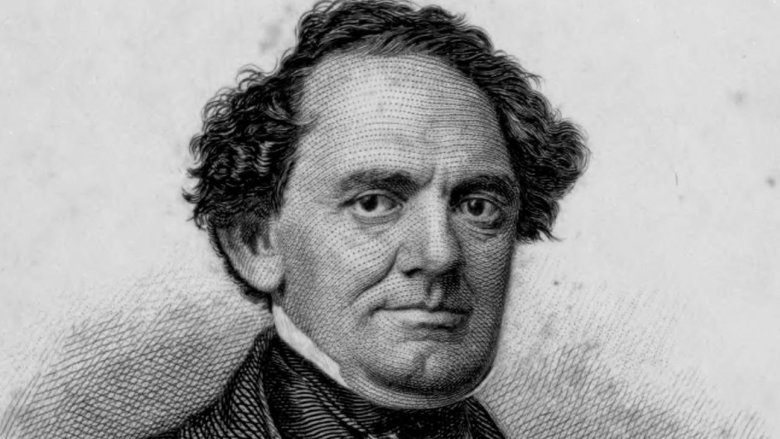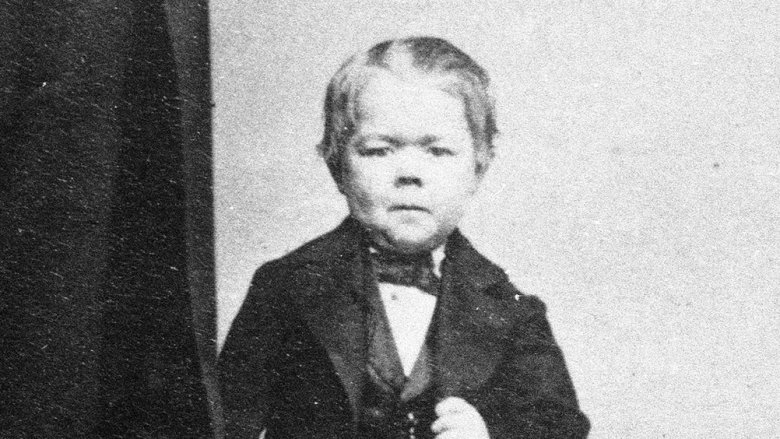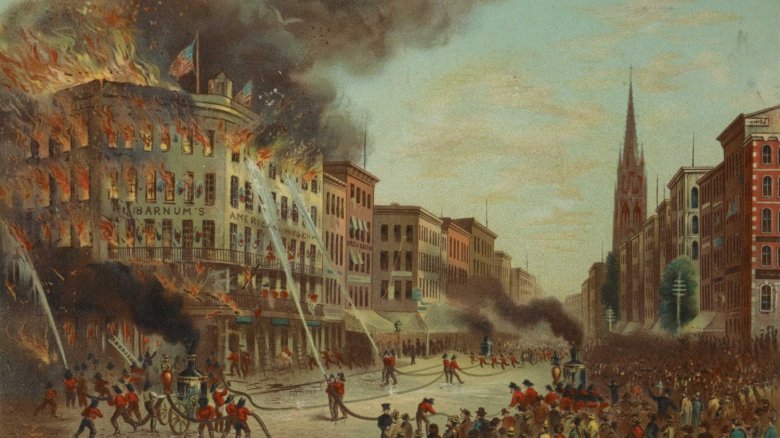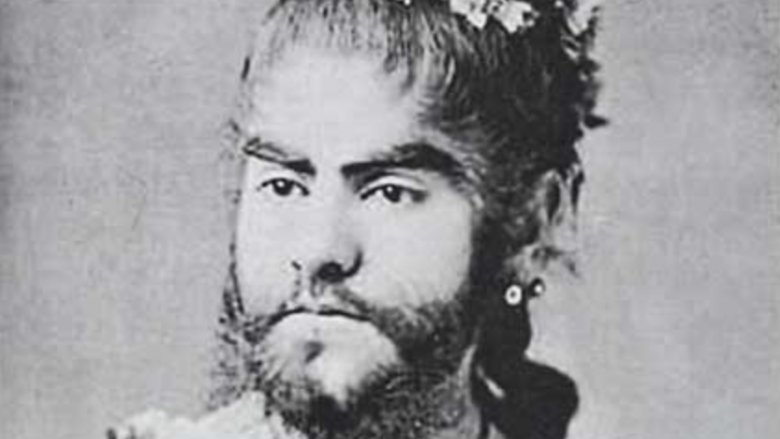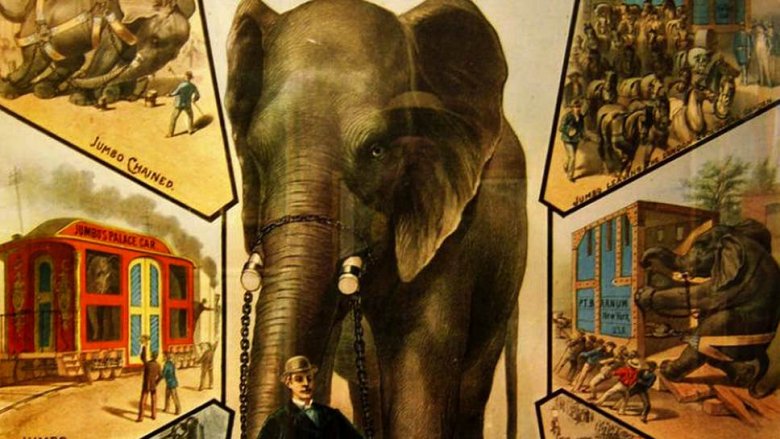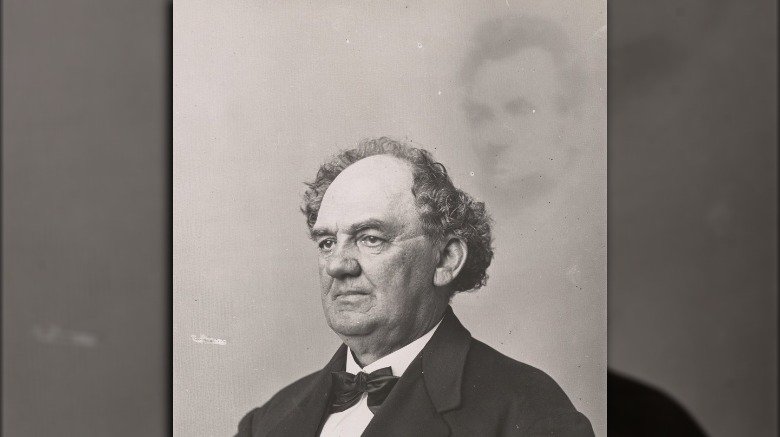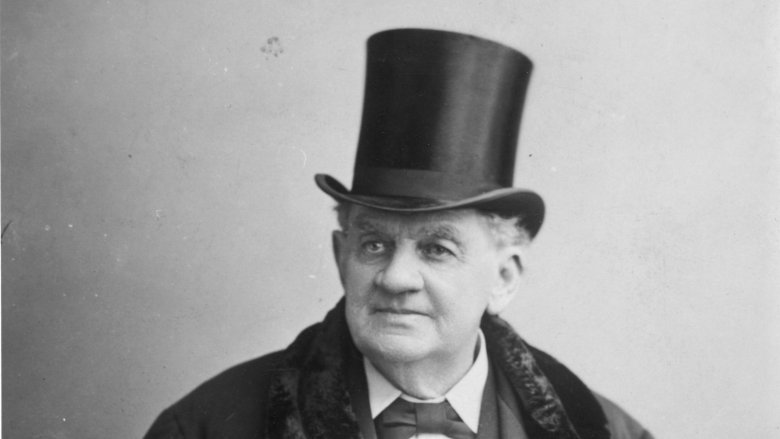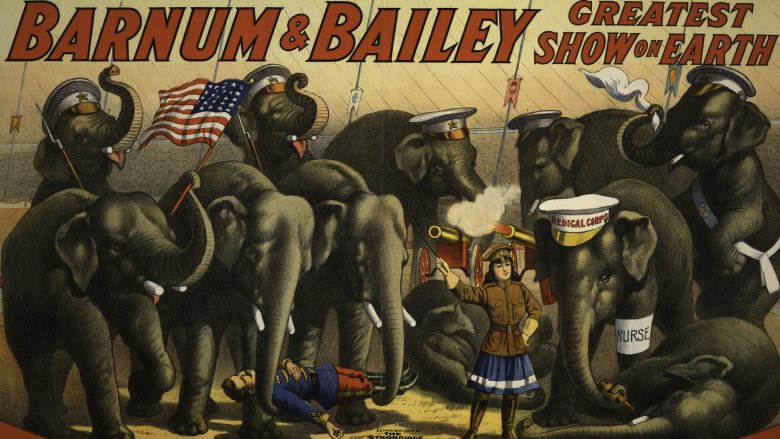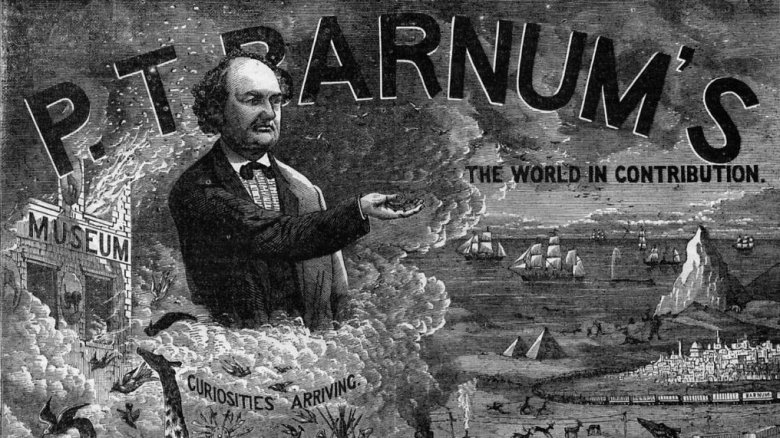The Messed Up Truth Of P.T. Barnum
When P.T. Barnum's name comes up these days, it's mostly for one of two reasons. Either A: because that the guy you know who uses the word "actually" too often wants to show everyone how smart he is by informing them that Barnum never said "there's a sucker born every minute," or B: because your coworker just saw The Greatest Showman and is totally shipping Zac Efron and Zendaya, or Hugh Jackman and Rebecca Ferguson, or one of the elephants and it doesn't matter who else, they just have a lot of feelings.
It may shock and amaze audiences far and wide to learn that the real P.T. Barnum was a spectacle far more astounding than the optimistic songbird presented on screen in The Greatest Showman. Step up, dear reader, and learn his story! Not just an entrepreneurial spirit, he was an American legend, a nonfiction folk hero, a demigod of gumption and wherewithal who walked among mortals and forever changed the landscape of entertainment!
Or depending on your perspective, he was a con artist slave owner who got an elephant killed. Let's explore P.T. Barnum.
P.T. Barnum's humbug beginnings
First things first. P.T. Barnum was, if nothing else, a deeply dishonest man who made a living off the gullibility of the public. That said, he came by his dishonesty honestly.
Phineas Taylor Barnum was born in 1810 and named after his grandfather, who almost immediately started screwing with him. At his grandson's christening, he gave the boy the deed to 5 acres of land called Ivy Island. Years of playing it up to the boy (and years of the boy telling everyone in town how rich he was) culminated in a trip to Ivy Island, which it turned out was less "magical isle of wonderment and possibility" and more "a patch of land in a swamp covered in acres of poison oak." Oh, how everyone laughed at him. According to his autobiography, he was 10 at the time.
This sounds like the origin story of an Adam West-era Batman villain, and to be clear, it basically was. It was, however, a slow burner: The road to becoming the patron saint of hucksters was a long one, and before getting into show business, Barnum would work in nobler fields, like as a sketchy boardinghouse employee, a newspaper publisher who was convicted of libel, and perhaps most successfully, the manager of a local lottery. When lotteries became illegal in his home state of Connecticut, he packed up his family and headed to New York.
And that, roughly, is where stuff started to get gross.
Showbiz for Barnum!
Just ask any of the No Doz-riddled optimists who camp out on the sidewalk for a week trying to get an audition for America's Got Talent: breaking into show business is hard. Luckily for P.T. Barnum, there are ways around that, provided you're willing to be biblical-grade evil.
At the tender age of 25, Barnum was looking to get his foot in the door of pretty much anything. He was working as part owner of a grocery store when he came across Joice Heth, an elderly (here comes the problematic stuff!) slave. The roughly 80-year-old woman was being exhibited as the 161-year-old ex-nurse to baby George Washington, but for whatever reason, people weren't buying the act.
That's where Barnum stepped in. Reckoning that selling the public on a century-and-a-half-old woman was more about branding than common sense, he circumvented the whole "it was illegal to buy slaves in New York at that point" issue by "leasing" Joice. He sold his stake in the grocery store, paid $500 out of pocket, borrowed another 500, and became the proud owner of a person.
Weirdly for a story about buying and selling human beings with thoughts and emotions, things got a little bleak from there.
Barnum goes body horror
Physically, there's no doubt that Joice Heth looked like an old woman when P.T. Barnum started exhibiting her, but she just wasn't the spectacle that he needed. Audiences up until that point had been unimpressed. So what do you do with a curiosity act that nobody's curious about? If you're P.T. Barnum, you go full-on evil sideshow proprietor and start torturing an old woman.
For starters, Barnum wanted Joice to shed some of those pesky extra pounds from which octogenarians so frequently suffer. To achieve this, he put her on a strict diet of eggs and whiskey. He also apparently figured that, while the chances of anyone living for over a century and a half were low, the odds that they could do it and still have teeth were probably astronomical. According to accounts in the Benjamin Reiss book The Showman and the Slave, what happened next went roughly like this: Barnum said, "You'd look older without teeth. You should let me pull those out of you," to which Heth replied, and we're paraphrasing here, "No." Barnum retorted, "Fair enough. How about a drink?" and then got Heth drunk. Really drunk. However drunk you have to be to say "Oh, all right, yank my teeth out."
It's impossible to say for sure why this story didn't make it into The Greatest Showman, but it may have been due to the difficulty inherent in juxtaposing a man mutilating an old woman so she'll better suit his needs against a song about accepting yourself no matter what you look like.
The last days of Joice Heth
Barnum turned Heth into a touring sensation, and made a killing doing it. By showing her off for 12 hours a day, six days a week, Barnum pulled in around $6,000 per month, precisely zero dollars of which went to Heth. Barnum's methods of advertising were dizzyingly machiavellian: At one point, he had a story printed in a Boston newspaper ahead of a visit claiming that Heth was "a curiously constructed automaton, made up of whalebone, India-rubber, and numbers springs that ingeniously put together, and made to move at the slightest touch according to the will of the operator." If the impossibly old woman who raised the father of our country didn't pique your interest, a terminator made of orca skeletons definitely would.
The exploitation of an enslaved woman in the free North didn't go unnoticed. When people protested what was clearly a violation of the law, Barnum made it known that Heth was actually a free woman and that the proceeds from her appearances went toward freeing her family in the South, and any of the "aw shucks" hokey traveling show charm of Barnum's business flies out the window when you realize that none of it was true.
Joice died within a year of going to work for Barnum. Consummate entrepreneur that he was, this didn't stop him: He held a public autopsy of her body and charged 50 cents for tickets.
Barnum gets into the circus scene
A year of starving an old lady and forcing her to work until she died left Barnum bitten by the showbiz bug. His next venture was called Barnum's Grand Scientific and Musical Theater. It was a traveling variety show featuring magicians, acrobats, and curiosities.
At this early phase in his career, however, his greatest success came when he met Charles Stratton. Stratton was a 5-year-old boy from Connecticut who had apparently stopped growing at around 6 months old. Barnum convinced Stratton's parents to let him take the kid under his wing. He taught Stratton how to perform and took him out on the road, only lying a little bit about how he was older than he actually was and also from England and also named "General Tom Thumb." The ruse brought an audience, and before long, Stratton was performing for Queen Victoria and Abraham Lincoln.
Charles Stratton is sort of the poster child for the duality of Barnum's methods. He was a young man with a disability that, at that point in history, would've left him without a lot of options in life, but he wound up a celebrity who died wealthy, beloved, and married, and none of that would've happened without Barnum. On the other hand, Barnum could be seen as someone who exploited a little boy, taught him to drink wine and smoke to amuse audiences, and lest we forget, also bought a woman and pulled her teeth out.
Barnum's American Museum
Despite the economic crisis of 1837, Barnum was doing all right for himself. Using the money he'd put together on the road, he purchased Scudder's American Museum, a five-story building in New York that was promptly rebranded as Barnum's American Museum. What had been a hit-and-miss collection of natural history exhibits and curiosities was given the typically over-the-top P.T. Barnum treatment. The building was filled with oddities, performers, and trained animals, and the advertising was just about what you'd expect. Visitors were promised sights such as the mummified "Feejee Mermaid," which was, in theory, the preserved corpse of a cryptid and, in practice, a monkey body sewn to a fish tail. All in all, the museum purportedly saw over 38 million visitors during its more than two decades of operation, a number slightly higher than the population of the United States at the time.
In 1865, Barnum's American Museum burned to the ground while fleeing animals jumped from its windows, trying to escape. No one knows how the fire started, though it's been blamed on a faulty chimney. The good news is that it was insured, though it's hard to say whether that was true of his second museum that burned down in 1868, or his circus that burned down in 1872, or his mansion that burned down in 1857.
Barnum's talent
During his time running the American Museum and in the years that followed, P.T. Barnum amassed a small battalion of performers with unique and unusual physical attributes. They became some of his most popular attractions, especially once he was done chumming the waters with aggrandizing lies.
The list of Barnum's performers is long and, these days, pretty troublesome. For fans of the truly heinous, there was William Henry Johnson. William was an African American man born to two former slaves. He had a distinctively sloped forehead that may or may not have been the result of microcephaly, so naturally Barnum put him in a gorilla suit from the neck down, told him to speak gibberish, and advertised him as the missing link. If the racist angle isn't gross enough for you, there's always his stage name, "Zip the Pinhead."
There was also Ella Harper the Camel Girl, a woman with knees that bent both ways. There were Chang and Eng, the conjoined brothers who became so well known that they gave birth to the phrase "Siamese twins." And of course, there was Annie Jones, the Bearded Lady, who, and this is neat, spent her later years championing efforts to get people to stop calling folks with physical abnormalities "freaks."
There was a philosophical rift between Barnum and his elephant
In his autobiography, Barnum claimed to have heard a firebrand minister speaking in 1847 on the subject of temperance. He said he became convinced of the potential evils of alcohol and famously expressed that he would "never drink anything stronger than water" when he spoke publicly about the importance of a booze-free lifestyle. This lent credibility to his constant deluge of shenanigans and made him, at the time, a more admirable political figure.
Whether Barnum actually believed this is, like literally everything else about him, up for some debate. According to the Greeley Tribune, he owned property in Greeley, then a dry city, but his property was nearly confiscated after it was busted twice for unlawful hooch sales while under the management of Barnum's in-laws.
And then there was the elephant in the room: Jumbo, Barnum's prize elephant and the reason we use the word "jumbo" to this day. Whatever Barnum's thoughts on alcohol, Jumbo apparently loved it, and was given entire kegs of beer to drink at a time, sort of visually prophesying John Belushi in a lot of ways. Adorable? Sure. But it was also very possibly a contributing factor to the animal's physical deterioration. Studies have found that Jumbo's diet led to deformities and infections in his teeth, potentially worsening the animal's infamous episodes of violent rage.
The one thing P.T. Barnum hated more than anything else
Overall, P.T. Barnum is remembered as a jovial sort of a guy, grinning his way through a life of puckish misdirection and, lest we forget, buying people and pulling their teeth out. But there was one thing the showman couldn't stand: liars.
With righteousness and the wellbeing of the public doubtless stoking the fires behind his every keystroke, Barnum wrote "The Humbugs of the World: An Account of Humbugs, Delusions, Impositions, Quackeries, Deceits and Deceivers Generally, in All Ages," and based on the title, was paid by the word. In it, he outlines the different ways that spiritualists, mediums, con artists, and hucksters would defraud the public. He adamantly stood by his belief that taking advantage of people through deception was wrong, saying in a letter, "As a general thing I have not 'duped the world' nor attempted to do so."
He also told people that a monkey sewed to a fish was a mermaid and fabricated a heroic death for his star elephant after negligence led to him being hit by a train, but whatever. He faked a photo of himself with Abraham Lincoln's ghost to help take down "spirit photographers" like William Mumler who skewed more on the totally trashy side of conning folks out of their money.
Barnum's later years
Barnum, for all of his faults, was a hard working man who didn't take a lot of time off. He didn't actually start the traveling circus he was most famous for until he was in his 60s, so his later years were spent traveling the world. On one of his trips, his wife, Charity, passed away from heart failure. According to Bridgeport History Society records, Barnum was in Germany at the time and decided to travel to England to be with a friend, John Fish, during his time of grief. Thirteen weeks later, he was married to Fish's daughter, Nancy, who was 40 years younger than he was.
In other slightly yucky news, Barnum cut one of his daughters out of his will when she cheated on her husband, presumably because of his intense dislike of (deep sigh) dishonesty. Not having any sons and wanting to keep his legacy alive, he left a good chunk of his money to his grandson on the condition that he use "Barnum" as his last name.
Barnum went out big
By the time he died, P.T. Barnum was arguably a living folk hero. He had entertained millions, been elected to the Connecticut House of Representatives and to the office of mayor in Bridgeport, and sold countless copies of his memoirs and self-help books. He'd traveled the world in search of the peculiar and incredible, and witnessed people and objects beyond the wildest imaginings of most men. He'd even read his own obituary.
According to P.T. Barnum: The Legend and the Man, Barnum had talked about how newspapers only printed nice things about people after they died. When his health began to decline in 1891, the New York Evening Sun apparently decided to do something about it: They printed a glowing obituary for him while he was still alive, just so he could read it. The front page article was titled "Great and Only Barnum – He Wanted to Read His Obituary – Here It Is."
Barnum's legacy
In the roughly 130 years since he died, P.T. Barnum has become a source of fascination on par with many of his own exhibits. He's been the subject of books, plays, TV movies, and an all-singing, all-dancing, musical Wolverine spectacular.
In the end, maybe the most intriguing thing about Barnum is that he remains impossible to define. His collection of "human curiosities," for example, could be seen as exploitation of the differently abled, yes. It could also be argued that his providing decent-paying work to folks with disabilities meant those people were able to live longer and more comfortably than they otherwise would have in a society with no other support system. His propagation of minstrel shows and sensationalist racial stereotypes are, through a modern lens, xenophobic and hateful. He also rallied hard in favor of the Thirteenth Amendment, arguing that all people, no matter their heritage, possessed an immortal soul and deserved to be free.
Maybe there is no answer to the question "What kind of man was P.T. Barnum?" Maybe, like everyone else, he was a complex hive of actions, positive and negative. To quote James Truslow Adams, "There is so much good in the worst of us, and so much bad in the best of us." Maybe a life is too complicated a thing to define as good or evil.
Except Barnum pulled the teeth out of Joice Heth's head and sold tickets to her autopsy, so no, the guy kind of sucked.
